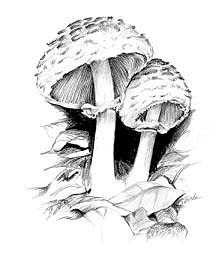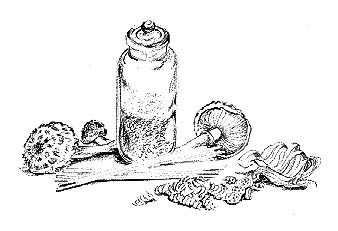Shaggy ParasolLepiota rhacodesThose who enjoy inventing common names for wild foods have named this hearty fungus the "shaggy parasol mushroom," but most collectors know it by its species name, rhacodes, pronounced "ra-ko-dees." Lepiota procera, a similar, more stately, and taller mushroom avidly sought for in the eastern United States and Europe, is simply known as the "parasol mushroom." It is highly favored and highly flavored. 
Lepiota rhacodes is found in the San Francisco Bay Area primarily under Monterey cypress and eucalyptus trees. It also occurs on the borders of compost heaps. This mushroom appears shortly after the first rains, and it fruits during the summer along the Pacific Coast after heavy fogs. It occurs worldwide. The Russians consider it their most beautiful mushroom. L. rhacodes is a large mushroom. Its cap may reach 7 inches across. The cream- or buff-colored top surface is decorated with crisp dark scales arranged in concentric rings or in interrupted patterns. Characteristically the color becomes orange to red-brown when the stem is cut or the tissues are bruised. The ample stem supports a thick, cushiony partial veil. The bottom of the stem is bulblike, occasionally surrounded by a volvalike border. Before the cap expands, the young brown specimens have long sturdy stems, and the top is round, giving it a drumsticklike appearance. Gills and spores are white at maturity. A very similar mushroom, Chlorophyllum molybdites, is found widely distributed in the United States, but is not commonly found in the San Francisco Bay area. It grows in warm moist areas and produces green spores, but only when mature. This is important to know, since C. molybdites can cause intestinal distress. Intense stomach discomfort may occur from eating raw L. rhacodes. They should only be eaten cooked. There have also been a few reports of minor reactions to cooked L. rhacodes. It would be wise to eat only a small amount of these mushrooms the first time you try them. CleaningRemove sand and humus with a soft brush and a minimum amount of water. Do not overwater them and wash the meaty flavor down the drain. CookingThe gills of the mature mushrooms are very fragile and tend to fragment when sliced. When cooked, these mushrooms turn deep brown. They have the appearance of meat when cut into thick broad slabs and fried in butter or grilled. You may include them in casseroles, meat loaves, long-cooking pot roasts, and with almost any rich sauce. Sautéed, they are superb as a side dish with roasts, steaks, and chops. The flavor of the dried mushrooms can become very intense when they are reconstituted in hot water. Resoak them in fresh water to reduce some of this pungency. Save the strong liquid to fortify a stew, sauce, soup, or even the same dish. We recommend a heavy red wine as an accompaniment, such as burgundy, cabernet, barbera, or bordeaux. PreservingDry the caps of L. rhacodes and set aside for 1 to 2 years. Like a fine wine, they improve and mellow with age, the aroma becoming increasingly rich. It is recommended that high temperatures be avoided in the dehydrating process. The gills are not crowded, so the drying time will be shorter than for most mushrooms (see information on drying mushrooms).  Shaggy Parasols with NoodlesServes 6 as a main course
ALTERNATE MUSHROOMS: Blewit, Morels, Shaggy Mane Beef and Red Wine in a Clay PotServes 6 as a main course
ALTERNATE MUSHROOMS: Black Saddle Mushroom, Hedgehog Mushroom Mushroom Potato KugelServes 6 as a side dish
ALTERNATE MUSHROOMS: boletes, common store mushroom |